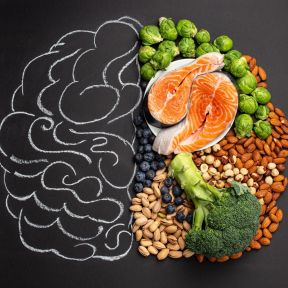
Metabolism
The complex machinery that mixes the fuel we consume as food with oxygen from the air we breathe to turn it into the energy that powers every cell and action of your body and brain is collectively called metabolism.
Because mental life is the product of physiological activity, such as the transmission of nerve impulses, every behavior you engage in, every thought and feeling you have—whether running or reading, loving or laughing, or even quietly meditating—depends on a suite of biological processes in the brain, operating at astonishing speed.
The brain accounts for only 2 percent of body weight, but it consumes 20 to 25 percent of the body’s fuel. Constantly working, it is a metabolically voracious organ. Its everyday fuel is glucose, a carbohydrate released into the bloodstream as food is digested in the gut. In a series of chemical reactions requiring oxygen, glucose is dismantled to yield adenosine triphosphate (ATP). The production of ATP and power from it takes place in the tiny substructures of cells called mitochondria. With its incessant energy demands, the brain is loaded with mitochondria, typically thousands per cell.
Evidence is accumulating that problems in brain energy metabolism are the basic cause of many—if not all—psychiatric disorders. According to the metabolic theory of mental illness, all mental disorders are metabolic disorders of the brain. The theory also opens doors to a whole new approach to the treatment of mental disorders.
Contents
Descendants of an ancient bacterium that made its way into a single-cell organism perhaps two billion years ago, mitochondria inhabit all cells of the body except red blood cells. Their job is to respond instantly to circumstances, whether you need energy to jump out of bed, pick up your toddler, or write a speech. You can’t read, dream, or kiss a loved one without a shot of energy in your brain.
In a series of quick chemical cascades relying on available oxygen, mitochondria harvest electrons from the progressive breakdown of glucose to create ATP. As energy demands increase, mitochondria can divide and multiply on their own, and they constantly move around and reshape themselves through fission and fusion to maintain oxidative capacity under stress.
It would be one thing if energy production were all that mitochondria do. In fact, they do much more. They produce and regulate neurotransmitters, including serotonin, dopamine, and GABA. They regulate hormones, including cortisol, an agent of the stress response, and the hormones of reproduction: estrogen, testosterone, and progesterone. Mitochondria modify the expression of cellular genes, turning them on and off. Everything they do has a major effect on mental processes, from what you think to how you manage your emotions (or fail to), and how you interact with others.
The sensitivity of mitochondria to situational needs makes them the hub of adaptation to events within and without. But that sensitivity is double-edged: It puts mitochondria at risk from all kinds of environmental disturbances, leading to some form of mitochondrial dysfunction. Mitochondrial dysfunction of some kind is now thought to be the source of all psychiatric disorders. Reduced ATP production, for example, has been found in various parts of the brain in autism, bipolar disorder, depression, and schizophrenia.
To remain in working order, all cells engage in a process of self-maintenance and self-renewal called autophagy, by which worn-out or damaged parts are broken down and removed, and reusable elements are up-cycled into new cells. Mitophagy is the process of upkeep and rejuvenation of mitochondria, and, given the amount of fuel mitochondria burn and other processes they are involved in, constant, meticulous housekeeping is essential to the viability and function of all cells, including brain cells. Mitophagy is a vital protective mechanism, a form of mitochondrial quality (and quantity) control, promoting the removal of compromised mitochondria.
Impaired clearance of dysfunctional mitochondria has emerged as an essential contributor to brain aging, neurodegeneration, and psychiatric conditions. Mutations of key molecules involved in mitophagy have been identified in Parkinson’s and Alzheimer’s diseases. Accumulating evidence suggests that both inflammation and mitochondrial dysfunction resulting from impaired mitophagy are linked to the pathogenesis of depression. Investigators are searching for ways to safely enhance mitophagy as a treatment for many psychiatric disorders, including depression.
In the chemical activity that produces ATP, some electrons escape and create free radicals of oxygen, also called reactive oxygen species (ROS). At low levels, ROS are important signaling molecules. But at high levels, they can damage DNA, proteins, and other cellular components. When the free radicals of oxygen outnumber the antioxidants available to neutralize them, the result is a condition called oxidative stress. ROS build up, damaging the mitochondria and the host cells. The brain is particularly vulnerable to oxidative stress, which is linked to aging, neurodegenerative diseases, and many psychiatric disorders.
Mitochondria are now seen as the unifying link for psychiatric illness because, as sensors of the internal and external environment, they must react quickly to changes in it. There are many ways the function of mitochondria can be reduced or impaired. Prolonged oxidative stress can erode their efficiency and activity or damage their genes. Sluggish debris removal can disrupt or impede activity.
Whatever the cause, the result is a decrease in energy production and an increase in ROS. Reduced brain energy is a source of fatigue and of cognitive fuzziness, and it especially undermines the brain’s most energy-intensive activity, executive function, affecting attentional focus, decision-making, impulse control, emotion regulation, and memory.
A mental state of challenge, stress consumes energy. Mitochondria generate the signals that enable adaptation to stress. And just as mitochondria respond to psychosocial experiences, they shape such experiences as well. Chronic stress affects many facets of mitochondrial biology, and changes in mitochondrial energy production capacity alter social behavior, stress reactivity, and mood. Changes in mitochondria are now believed to be a major way that adversity stamps biology, setting the stage for the development of disease.
Early life trauma, such as severe or multiple adverse childhood experiences (ACEs), appears to reprogram mitochondrial energetics. Researchers find that more mutations of mitochondrial DNA in adult women with major depression who had experienced parental loss or maltreatment in childhood compared to women without depression. Early damage to mitochondrial DNA can lastingly alter many elements involved in mitochondrial energy production.
In many ways, depression can be seen as a disorder of neuroplasticity. People are stuck cognitively, emotionally—and neurally. They lack psychological and behavioral flexibility. Along with the diminished energy that characterizes depression, the lack of neuroplasticity is now seen as rooted in metabolic malfunction. After all, the energy for neuroplasticity must be supplied by mitochondria, which also regulate the calcium ions essential for synaptic function and neurotransmission.
There’s evidence that mitochondrial dysfunction also influences suicide. Researchers have identified specific molecules that identify depressed people engaging in suicidal thinking—all Tests that measure blood levels of certain mitochondrial metabolites may be of value in predicting which people are at risk of suicide. Targeting mitochondrial operations may yield the next generation of drugs for treating depression.
The new understanding of metabolic dysfunction as the common pathway of mental disorders ushers in not only a new approach to treatment but also a re-evaluation of existing treatments and a revised understanding of their value. There are already many known ways to influence metabolic function.
For example, it is well-established that some behaviors undermine mitochondrial function, and limiting them takes on a new urgency. Poor sleep and poor diet are among them. So is excessive stress. While it isn’t always possible to limit the amount of stress in one’s life, it is possible to learn, even at an early age, a wide range of all-purpose coping skills—from deep breathing to expressive writing to meditation.
There are also known measures that increase mitochondrial fitness. To all the well-established reasons for engaging in regular physical activity, add another— it boosts mitochondrial function. Physical exercise stimulates mitophagy, improving mitochondrial housekeeping and clearance of debris.
Among its many restorative functions, sleep counteracts oxidative stress. That, in fact, may be why we sleep. While we sleep, mitochondria are busy reshaping themselves to rebalance their energy-producing capacity. Sleep deprivation decreases their capacity to produce ATP. Sleep not only rejuvenates mitochondrial function, but good mitochondrial function is essential for the ability to sleep. It turns out that mitochondria play a central role in regulating the circadian clock that controls the sleep-wake cycle.
The food we eat supplies the fuel that mitochondria burn for energy. Their primary fuel is glucose, supplied by carbohydrates. The foods we choose also contain many other nutrients and other bioactive components essential for mitochondria.
As a result, poor diet is another lifestyle element that takes a huge toll on mitochondria. For example, while mitochondria make some of the antioxidants needed to defend against ROS, most antioxidants must be supplied by diet, and they are found primarily in fruits and vegetables. Given the constant activity of the brain, antioxidants are continuously needed to combat oxidative stress.
Among the nutrients known to protect mitochondria against oxidative damage are:
• Antioxidants—Abundant in fruits and vegetables, they directly neutralize ROS, limiting oxidative stress.
• Omega-3 fatty acids—They maintain the fluidity of mitochondrial membranes and increase the efficiency of ATP production, curbing oxidative damage.
• B vitamins—Signaling molecules and cofactors for many of the chemical reactions in mitochondria, they modulate and maintain the efficiency of mitochondrial activity.
• Magnesium—The mineral boosts the efficiency of ATP production and reduces the production of reactive oxygen species, curtailing oxidative stress.
Foods contain many other compounds that have biologic effects beyond their nutrient value, and many of them contribute to energy production. Among such substances:
• NAC, or N-acetylcysteine—an antioxidant
• Co-enzyme Q10—another antioxidant
• L-carnitine—an amino-acid derivative that is an essential co-factor in energy production
• S-AME, or S-adenosyl methionine—a co-factor for many enzymes used in mitochondria, including for regulating DNA and RNA transcription
Ketogenic diets have been used for more than a century to reduce the frequency of brain seizures in infants and children with epilepsy. Low in carbohydrates and protein but high in fats, ketogenic diets force mitochondria to burn fats as fuel instead of glucose.
More efficient in the production of ATP, ketogenic diets influence the firing ability of neurons by regulating the neurotransmitters GABA and glutamate and by regulating calcium ions. They also beef up mitochondrial metabolism and neurotransmitter function, while minimizing oxidative stress and inflammation. Ketogenic diets also stimulate mitophagy, leading to increased numbers of healthy mitochondria in cells.
Physical activity stimulates mitophagy to repair, recycle, or eliminate damaged mitochondria by mitophagy, and it stimulates the synthesis on new mitochondria (biogenesis). But it is important that physical activity be of moderate intensity.






